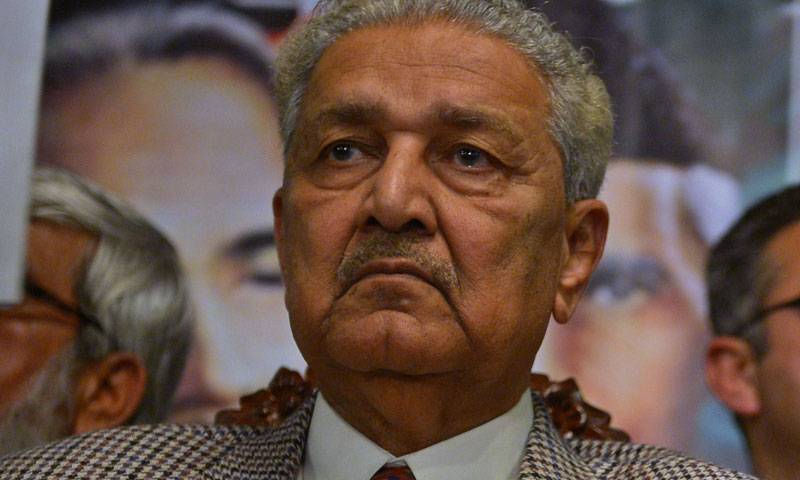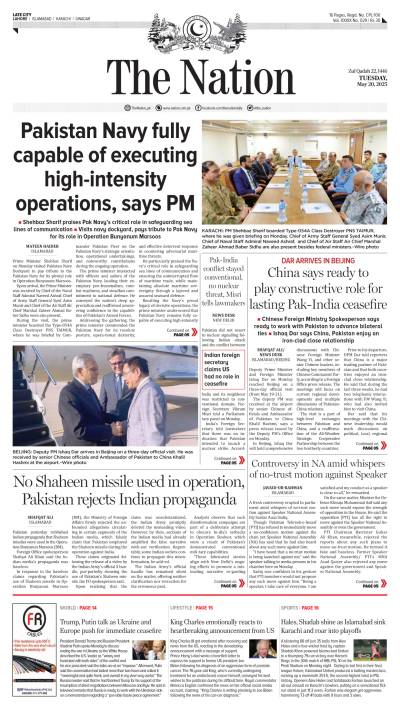India carried out its first underground nuclear explosion in 1974 at Pokharan in Rajasthan Desert. It was termed a “peaceful Nuclear explosion”, code-named Smiling Buddha. The world looked the other way. For Pakistan it sounded like a death knell. India was several times Pakistan’s size and already possessed overwhelming superiority in conventional arms - by the dint of which it forcibly separated Pakistan’s Eastern wing. With that explosion, it had also become a nuclear power.
At that critical juncture, a young Pakistani Nuclear Scientist, Dr. Qadeer Khan, who was working abroad at the time, offered his services to the Government of Pakistan, which were mercifully accepted, after some initial hesitation.
Development of nuclear weapon’s capability was started in earnest at Kahuta research lab In 1976, under the Armed forces watch. It was to the great credit of Dr. Qadeer Khan and his brilliant team of scientists and Technicians that Pakistan achieved nuclear weapon’s capability by 1984 - in a mere eight years - compared to decades of research by the Indian scientists. It showed that given the necessary resources and freedom of action, our scientists, professionals and soldiers were second to none.
Pakistan kept it a well-guarded secret till India carried out its second lot of five nuclear explosions in 1998. Pakistan responded by exploding six devices starting on 28 May 1998. Pakistan became the seventh member of the nuclear club and the first among 57 Muslim countries of the world. Strategic balance, which is the very essence of peace, was thus restored between India and Pakistan.
USA and the west merely “slapped India’s wrist” while severe penalties were imposed on Pakistan for those nuclear explosions. They underestimated the resilience of the Pakistani people and their indomitable spirit. Pakistan not only survived but also made tremendous strides in the field of nuclear weapons/missile technology. Thus, Pakistan achieved substantial numbers of nuclear devices - with second strike capability - based on the Trident concept (launch by air, land and sea) to ensure deterrence credibility.
However, it was soon realised that the credibility of the strategic deterrence, would be somewhat suspect with nothing in between the conventional forces and the strategic nuclear weapons. It was obvious that Pakistan would not launch its strategic weapons, if the enemy were to intrude just by a few miles (without threatening any vital areas). That is why some Indian generals had mentioned the possibility of limited conventional operations “under the nuclear threshold”. In fact India’s Cold-Start Doctrine – of a limited lightning strike - was based on that very assumption.
However, the scientists of Pakistan poured cold water over Indian designs by developing battle-field tactical nuclear weapons. These are miniaturised sub-kiloton nuclear warheads capable of being launched through multi-barrel launchers or by short range missiles. In all probability, the tactical nuclear weapons would be used to destroy enemy forces inside own territory, if the enemy forces were to penetrate threateningly. Thus, the employment of strategic nuclear weapons resulting in MAD (mutual assured destruction) would not be resorted to. Hence, the tactical nuclear weapons reinforce the credibility of strategic deterrence.
Nuclear weapons, whether strategic or tactical, are of little use unless proper delivery systems are developed. Apart from the existing capability to deploy nuclear weapons (by land, air and sea) Pakistani scientists have developed, multirange, multimode (Ballistic/cruise) missiles, with solid and liquid fuels, which can carry the nuclear warheads from less than 100 km to well over 2500 km range – thus covering every nook and corner of the enemy’s territory.
The development of tactical nuclear weapons has rattled the Indians. They seem to have lost their sense of balance. They have threatened to use strategic nuclear weapons should Pakistan were to use tactical nuclear weapons! According to their convoluted logic, they would much rather prefer to destroy both the countries than to face a reversal on the battlefield.
A rather surprising response has lately come from the President of USA, who decried the development of tactical nuclear weapons and shortrange missiles by Pakistan! Once again the “bogey” of nuclear weapons particularly the tactical nuclear weapons falling in the wrong hands, was being raised. It was also asserted that by the development of the battlefield tactical nuclear weapons and short range missiles Pakistan was “heading in the wrong direction”.
By developing battled field miniaturised sub-kiloton nuclear war heads, Pakistan was following none other than the doctrines of “Counter-Force” and “Flexible-Response”, evolved and propounded by the US thinkers of the Cold War era and adopted by USA and NATO forces against the overwhelming superiority of soviet union’s conventional arms. Strategic and tactical balance was thus maintained during Cold War years which ensured peace. So how come, Mr. President (with all due respect), what was good for the duck was no longer good for the drake?
It was obvious that double standards had become the norm of the Western powers. India had been provided access to dual-use nuclear technology and unlimited access to uranium stockpile inspite of not having signed the NPT - even allowing eight of India’s 26 nuclear facilities to remain outside the IAEA safeguards, which would enable India to produce a large number of nuclear weapons in a comparatively short time (estimated at 50 additional war- heads / year). And now USA is trying to get India onboard the Nuclear Suppliers Group.
India’s latest test of sea-launched missile from a submerged nuclear submarine and testing of its supersonic Anti-missile missile Ashwin to intercept missiles, has once again upset the balance of power between India and Pakistan. USA and the west have chosen to ignore those unsettling developments. It was obvious that India, inspite of its teeming millions living in abject poverty, was spending billions in amassing conventional as well as nuclear weapons, to dominate south and west Asia and to contain China, with the overt and covert backing by USA!
Pakistan’s nuclear programme was strictly in response to India’s and was based on maintaining strategic and tactical balance with minimum of deterrence to ensure peace in the region. The unlimited and unchecked supply of nuclear fuel to India, the sale of most advanced weaponary and technology to India and India’s nuclearisation of Indian Ocean alongwith its latest anti-missile tests would obviously force Pakistan to further add to its capability to restore balance. Thus, an arms race had been initiated in south Asia by none other than USA and the west, to the detriment of peace in the region and with all the possibilities of blow-back against the west and the rest.






